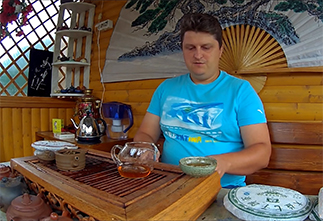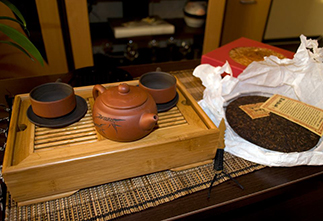The aroma of dry tea leaves when warmed by breathing is rich, resinous, with a clear predominance of citrus notes and dried tangerine peels, with woody notes of shu puer distantly reminiscent of themselves.
After washing, the aroma intensifies, and the shades of shu puer actively manifest themselves: steamed wood, dried nuts, prunes.
The taste of brewed tea is bright, moderately sour, slightly dry with rich citrus tones. You can feel orange in chocolate, tree bark, young nuts.
As the infusions increase, the oily citrus flavor fades and is replaced by damp wood, autumn forest, and moss.
The aftertaste has a characteristic sourness, candy-like sweetness and woody-nutty notes.
This tea is a good tonic, gives strength and confidence. It has a good warming effect.
Shu puer in tangerine should be brewed in the classic way, by pouring in a gaiwan at the rate of 10 grams of tea per 100 ml of boiling water. To enhance the tangerine flavor, you can add dried peel to the tea leaf to taste.
Shu puer aged in a tangerine is an interesting, tasty and original tea with a bright taste and high-quality tea condition.
|
English name
|
Ripe pu'er in tangerine “Golden Horse” |
|
Translation
|
Shu Puer in Mandarin "Golden Horse" |
|
Country
|
China |
|
Provinces
|
Yunnan (云南) |
|
Manufacturer
|
Золотая лошадь (金马) |
|
Declared weight, g
|
25 |
|
Size
|
4x4x4 |
|
Length, cm
|
4 |
|
Width, cm
|
4 |
- Комментарии
- Вконтакте
Pu-erh is one of the most unique types of tea, which only gets better with age. Many people, when they first encounter this tea, wondered: why is pu-erh more often found in pressed form (cakes, bricks, tochas), and not in loose form? The reasons for this are related to both history and the practical aspects of storing and fermenting tea. Despite modern technologies that allow the production of loose pu-erh, the shape of pressed cakes remains unchanged. And pu-erh is more often found on sale in pressed form, for example, in the form of cakes or bricks, and loose pu-erh is less common. We will talk about the reasons for pressing pu-erh into cakes in this article.
Puer is a unique Chinese tea that is distinguished by its depth of taste, complexity of aromas and versatility of aftertaste. Its taste characteristics are formed under the influence of many factors, from growing conditions to the brewing method. Let's look at the main ones.
The question often arises: how to brew puerh correctly? Sometimes the phrase "to get high" is added to it. Moreover, everyone has their own understanding of this phrase. Some mean vigor, and some - intoxication. So how to brew puerh tea correctly? Let's consider several options.
Traveling through the tea mountains, we found ourselves in another land of blue roofs - the village of Zhongcai, which is located in the Menghai district of Yunnan province. According to tradition, we were shown another local tea tree, which, according to the Chinese, is at least a million years old :) The village is very authentic, not designed for tourists, there are many wild pu-erhs there and, of course, we were warmly received. They treated us to local cuisine and tea. We also asked the residents about the prices of tea and how they have changed in recent years.
The tea ceremony occupies a special place in the centuries-old Eastern tradition. And although the essence of this phenomenon remains constant, the nature and external manifestations of the tea ceremony in different nations have their own national characteristics. In each Chinese province, the tea ceremony and the tea used in it are varied: for example, residents of the southern provinces prefer green tea, and residents of the northern provinces - red tea, in Fujian province they more often use Oolong tea, and in Yunnan province Puer tea is widely known.
























































































